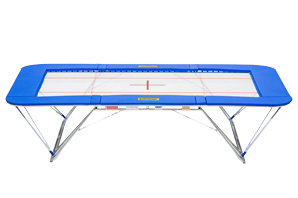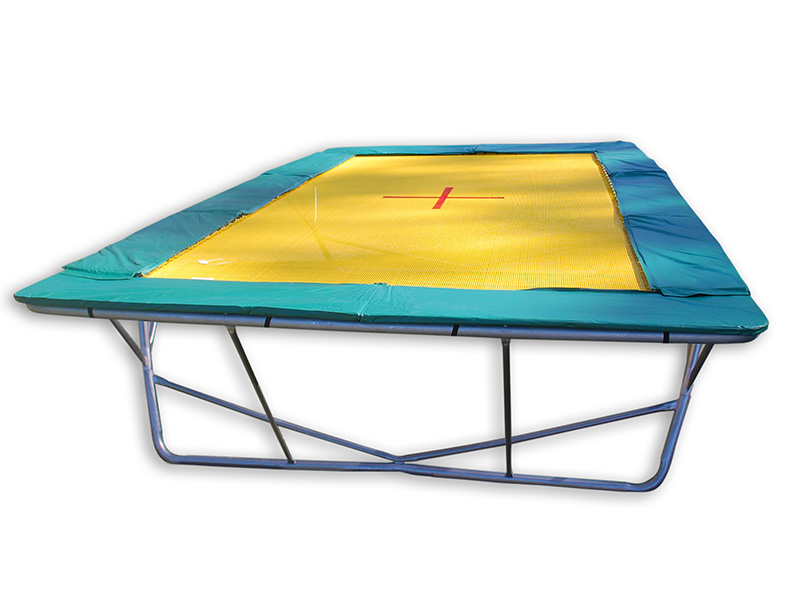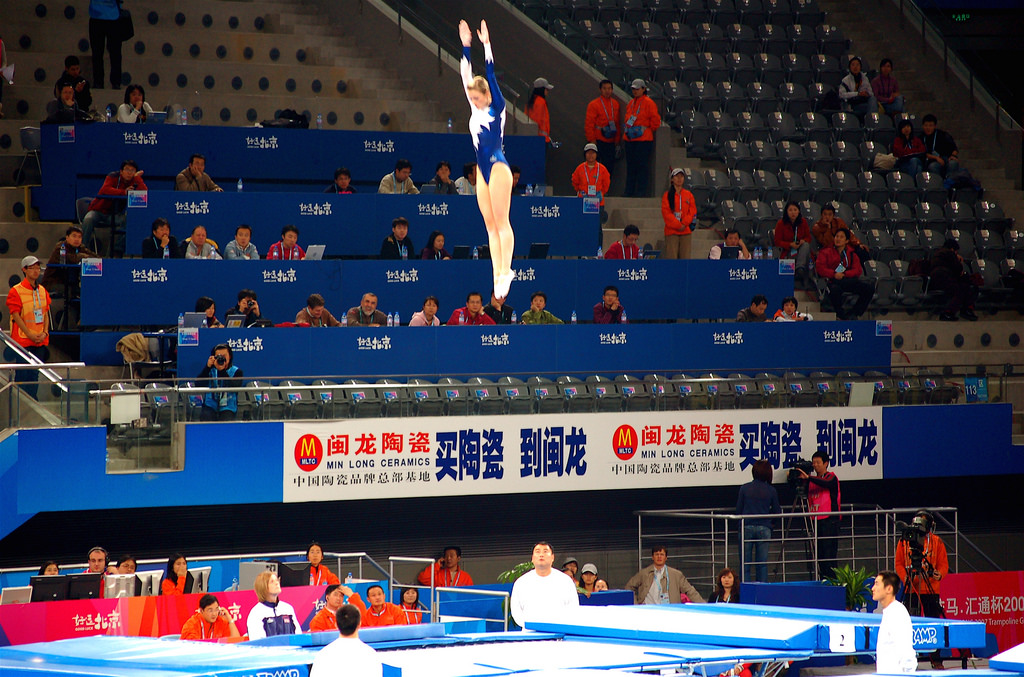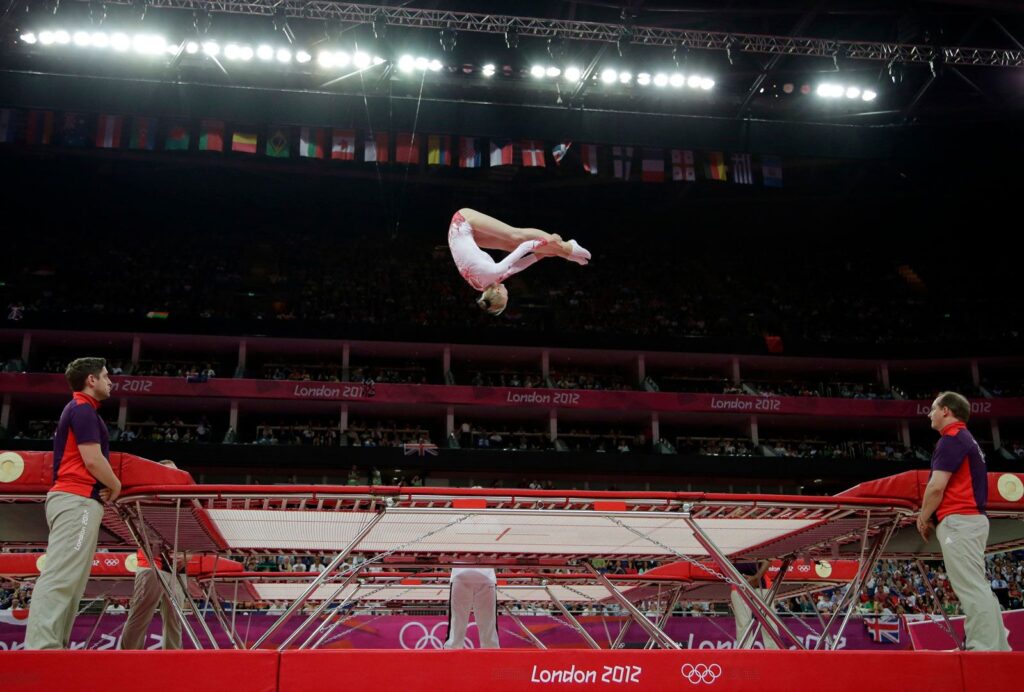Olympic trampolines are specialized equipment used in gymnastic competitions for power and precision. They differ from recreational trampolines in size, bounce, and structure.
Trampolining became an Olympic sport in the year 2000, and since then, athletes have awed audiences with their aerial acrobatics. These high-performance trampolines are designed to ensure maximum safety while allowing gymnasts to reach heights of up to 10 meters during their routines.
The sport requires incredible skill, with participants executing complex flips and twists. The trampolines used in the Olympics are rectangular, measuring about 5. 05 meters in length and 2. 91 meters in width, with a bed made of woven string material that offers superb elasticity. Safety pads cover the springs and frame to protect the gymnasts. These trampolines are precision-engineered to aid athletes in performing consistent and technically demanding routines, challenging their strength, timing, and spatial awareness.

Credit: gymaid.com
The Thrill Of Olympic Trampolines
The Olympic trampoline delivers an adrenaline rush like no other. Athletes soar to gravity-defying heights, performing breathtaking spins and flips. Each leap is a blend of precision, power, and grace. This spectacle of aerial artistry captivates audiences worldwide. Let’s dive into the world of Olympic trampolining and discover its rich history and the specifications that make it so thrilling.
History In The Olympics
Trampolining made its Olympic debut in Sydney, 2000. It showcased the world’s best athletes battling for aerial supremacy. Since then, it has become a staple of the Olympic Games. Its history reflects a journey from wartime training tool to a competitive discipline. Over time, trampoline gymnasts have pushed the boundaries of what’s possible in the air.
Trampoline Specifications
The Olympic trampoline boasts features that enable high flight and safety. Here are key specifications:
- Size: The trampoline bed measures 5.05 meters by 2.91 meters.
- Frame: A sturdy frame supports the bed, maximizing bounce.
- Material: The bed is woven from webbing for optimal elasticity.
Olympic trampolines must meet precise standards set by the International Gymnastics Federation (FIG). These standards ensure fair competition and safety for all the athletes involved.
| Attribute | Specification |
|---|---|
| Dimensions | 5.05m x 2.91m |
| Spring Count | Approximately 110 springs |
| Frame Height | 1.155 meters tall |
| Bed Material | Woven webbing or similar material |

Credit: www.topline-trampolines.com.au
A Leap Above: Olympic Athletes
Imagine flying through the air, flipping and twisting with grace. Olympic trampolinists do just that. They bounce higher and perform tricks that leave crowds in awe. These athletes train hard to perfect their moves. Let’s jump in and explore their world.
Training Regimens
Olympic trampolinists follow strict routines. Each day, they spend hours practicing. Their leg muscles must be very strong. They also learn to control their bodies while spinning and flipping.
- Strength training: Vital for high jumps
- Flexibility: Helps in performing complex moves
- Stamina: Allows longer training sessions
Besides physical exercises, trampolinists study videos. They watch their previous jumps to improve. Mental preparation is key. It helps focus during contests.
Celebrated Trampolinists
Olympic trampolines have seen many stars. These sports heroes inspire the next generation.
| Name | Country | Olympic Medals |
|---|---|---|
| Rosie MacLennan | Canada | 2 Gold |
| Dong Dong | China | 1 Gold, 2 Silver, 1 Bronze |
| Karen Cockburn | Canada | 3 Silver, 1 Bronze |
Each champion started as a beginner. They followed their dreams. One jump at a time, they reached the stars. Young jumpers look up to them. They strive to leap just as high.
Physics In Motion: Understanding Bounce
Olympic trampolines are engineering marvels designed to reach staggering heights. They use intricate physics principles to boost athletes skyward. To fully appreciate these bounces, we need to explore the science that makes it all happen.
The Science Behind Trampoline Mechanics
How does a trampoline work? It’s all about converting energy. A trampolinist begins with potential energy. Jumping down transforms it into kinetic energy. The trampoline fabric stretches, storing this energy momentarily. It then snaps back, releasing this energy and propelling the athlete upward.
- Elastic Surface: The trampoline’s surface is flexible yet strong. It stretches as force applies and rebounds energy.
- Spring Action: Springs or cords secure the fabric, allowing for elasticity and tension.
These components work in unison, creating a cycle of energy transformation that defines the physics of trampolining.
Impact On Performance
Every bounce on the trampoline is a test of physics. Stronger jumps compress the trampoline more. This creates more rebound force. Athletes use this to perform impressive aerial twists and flips.
| Jump Height | Compressed Depth | Rebound Force |
|---|---|---|
| Lower Jump | Less Depth | Lesser Force |
| Higher Jump | Greater Depth | Greater Force |
Understanding these principles helps athletes refine their techniques. They adjust their body position and force, aiming for optimal bounce and control.
Proper form and timing are crucial. They lead to better performance. Athletes strive for that perfect bounce. It takes them higher, and it helps them compete at the Olympic level.

Credit: lolakarimovatillyaeva.com
Global Flips: Trampoline Competitions
Olympic trampolines are not your average backyard bouncers. They are high-performance equipment used in global trampoline competitions. Athletes fly up to 33 feet in the air, performing awe-inspiring flips and twists. These global events showcase the peak of human agility and acrobatics. Let’s dive into the heart of the action!
Qualification Process
Becoming an Olympic trampolinist is no easy feat. It requires years of training and dedication. Here’s a rundown of how athletes earn a spot to compete:
- Regional competitions: Athletes must first prove their skills locally.
- National championships: Winners move on to represent their countries.
- World events: The top performers secure their places at the Olympics.
Scoring System Explained
In trampoline gymnastics, scoring is complex. Judges look for height, form, and difficulty. Here’s a breakdown of the point system:
| Component | Description | Point Value |
|---|---|---|
| Execution | How well the routine is performed | Up to 30 points |
| Difficulty | The complexity of the skills | Varies by move |
| Time of Flight | The duration spent airborne | Measured in seconds |
| Horizontal Displacement | The control over bounce location | Deductions for deviation |
Each routine is meticulously evaluated. Final scores tally up, deciding the winners who have combined athletic precision with daring acrobatics.
Health And High Jumps: Safety Measures
Olympic trampolining offers athletes the thrill of soaring heights. Yet, the spectacle carries risks. In this high-flying sport, safety is paramount. The following sections delve into the critical measures that keep gymnasts secure. Understanding these precautions ensures the athletes’ well-being remains the top priority while they push the bounds of gravity.
Preventing Injuries
Safety starts with injury prevention. Trampolinists must follow strict training regimens. Coaches enforce specific techniques that reduce harm. Spotting rigs provide a secure way to perfect acrobatic moves. Regular checks of equipment condition are essential. Routine inspections catch potential issues before they lead to accidents.
- Warm-up exercises to prepare muscles
- Spotted practice sessions for new skills
- Incremental skill advancement to prevent overexertion
Equipment And Gear Standards
Olympic trampolines adhere to rigorous specifications. The International Gymnastics Federation (FIG) defines these criteria. Trampolines must meet precise dimensions and material quality. The surrounding area features padding to cushion falls. Athletes wear appropriate attire, including grippy shoes and comfortable, non-restrictive clothing. This gear ensures maximum performance and safety.
| Equipment Part | Specification |
|---|---|
| Frame Size | 520cm x 305cm |
| Bed Material | Woven nylon or string |
| Spring Count | At least 110 springs |
| Padding Thickness | Minimum 20mm |
Beyond The Games: Trampoline’s Influence
The trampoline, a symbol of joy and gravity-defying fun, extends its influence far beyond the Olympic Games. It shapes culture and technology in unique ways. Let’s explore how this bouncy apparatus impacts our world in fascinating ways, both culturally and technologically.
Cultural Impact
Trampolines bounce into everyday life, entertaining and inspiring people across the globe. It’s not just about the athletes; it’s about the backyard jumps, movie stunts, and even fitness trends that have propelled trampolines into the cultural spotlight.
- Circus and acrobatic shows spotlight trampolines to wow crowds.
- Films and TV often feature trampoline stunts for dramatic effect.
- Trampoline-based fitness classes have soared in popularity, merging fun and exercise.
- Social media challenges and viral videos often star trampolines, showcasing creativity and skill.
Advancements In Trampoline Technology
As trampolines leap forward, technology enhances safety and performance.
| Year | Innovation | Impact |
|---|---|---|
| 2000s | Springless designs | Reduced injury risk |
| 2010s | Enhanced materials | Increased durability |
| 2020s | Smart trampolines | Integrated fitness tracking |
The evolution of trampoline technology leads to better, safer bouncing experiences. In Olympic arenas, these advances mean higher, more precise jumps. At home, they translate to safer recreation and fitness for families and enthusiasts alike.
Frequently Asked Questions On All About Olympic Trampolines
What Are Olympic Trampolines Made Of?
Olympic trampolines utilize high-quality materials to optimize performance and safety. Their beds are made from a woven fabric, which is often permatron, to provide exceptional bounce. The frames are typically constructed from steel, ensuring sturdy support for athletes during high-intensity routines.
How Big Is A Standard Olympic Trampoline?
Standard Olympic trampolines measure approximately 16. 5 feet by 9. 5 feet (5 x 3 meters). Their size allows athletes to perform complex aerial skills. The bed area where athletes bounce is around 14 feet by 7 feet (4. 28 x 2.
14 meters), providing ample space for safe landings.
What’s The Maximum Height Athletes Reach On Olympic Trampolines?
Athletes can soar up to 33 feet (10 meters) on Olympic trampolines. The precise height varies based on their skill, technique, and physical strength. This significant airtime is essential for performing multiple somersaults and twists before landing.
How Often Are Olympic Trampolines Replaced?
Olympic trampolines are replaced as needed, which largely depends on their usage and maintenance. For events like the Olympics, they’re often new to ensure optimal safety and performance. Training trampolines may have a longer life but are monitored closely for wear.
Conclusion
To sum up, Olympic trampolines offer athletes a stage for awe-inspiring feats, blending agility, strength, and precision. Our exploration into their make, regulations, and performance impact underlines their significance in competitive gymnastics. Whether you’re a budding gymnast or an enthusiast, understanding these trampolines is key to appreciating the sport’s spectacular dynamics.
Embrace the bounce and the thrill of Olympic trampolining!


